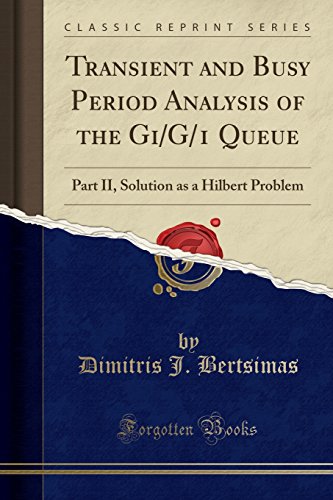Items related to Transient and Busy Period Analysis of the Gi/G/1 Queue:...
Transient and Busy Period Analysis of the Gi/G/1 Queue: Part II, Solution as a Hilbert Problem (Classic Reprint) - Softcover

Synopsis
Excerpt from Transient and Busy Period Analysis of the Gi/G/1 Queue: Part II, Solution as a Hilbert Problem
In this subsection we define the random variables and establish the notation we are using. We assume that the system is initially idle and the first customer's arriving time is the forward recurrence interarrival time. Although this assumption is restrictive for the waiting time distribution, it is not restrictive for the busy period distribution, since the busy period regenerates.
About the Publisher
Forgotten Books publishes hundreds of thousands of rare and classic books. Find more at www.forgottenbooks.com
This book is a reproduction of an important historical work. Forgotten Books uses state-of-the-art technology to digitally reconstruct the work, preserving the original format whilst repairing imperfections present in the aged copy. In rare cases, an imperfection in the original, such as a blemish or missing page, may be replicated in our edition. We do, however, repair the vast majority of imperfections successfully; any imperfections that remain are intentionally left to preserve the state of such historical works.
"synopsis" may belong to another edition of this title.
Search results for Transient and Busy Period Analysis of the Gi/G/1 Queue:...
Transient and Busy Period Analysis of the Gi/G/1 Queue: Part II
Print on DemandSeller: Forgotten Books, London, United Kingdom
Paperback. Condition: New. Print on Demand. This book contributes to the fields of probability theory and queueing theory by presenting a mathematically rigorous approach to analyzing the transient behavior of the GI/G/1 queue. The GI/G/1 queue represents a queue with general inter-arrival times and general service times. By formulating the problem as a two-dimensional Lindley process and transforming it to a Hilbert factorization problem, the author derives closed-form expressions for the Laplace transforms of the waiting time distribution and the busy period distribution. These results extend and generalize previous findings for specific queueing models and provide valuable insights into the behavior of queues with arbitrary distributions. The author employs advanced mathematical techniques, including the method of stages, separation of variables, root finding, and linear and tensor algebra, to achieve these solutions. The book is suitable for researchers, graduate students, and practitioners in the fields of operations research, applied probability, and queueing theory who seek a comprehensive understanding of transient queueing analysis. This book is a reproduction of an important historical work, digitally reconstructed using state-of-the-art technology to preserve the original format. In rare cases, an imperfection in the original, such as a blemish or missing page, may be replicated in the book. print-on-demand item. Seller Inventory # 9781333735326_0
Quantity: Over 20 available
Transient and Busy Period Analysis of the GiG1 Queue Part II, Solution as a Hilbert Problem Classic Reprint
Seller: PBShop.store UK, Fairford, GLOS, United Kingdom
PAP. Condition: New. New Book. Shipped from UK. Established seller since 2000. Seller Inventory # LW-9781333735326
Quantity: 15 available
Transient and Busy Period Analysis of the GiG1 Queue Part II, Solution as a Hilbert Problem Classic Reprint
Seller: PBShop.store US, Wood Dale, IL, U.S.A.
PAP. Condition: New. New Book. Shipped from UK. Established seller since 2000. Seller Inventory # LW-9781333735326
Quantity: 15 available
TRANSIENT & BUSY PERIOD ANALYS
Seller: moluna, Greven, Germany
Condition: New. KlappentextrnrnExcerpt from Transient and Busy Period Analysis of the Gi/G/1 Queue: Part II, Solution as a Hilbert ProblemIn this subsection we define the random variables and establish the notation we are using. We assume that the syste. Seller Inventory # 2148078298
Quantity: Over 20 available

